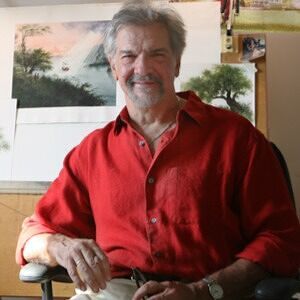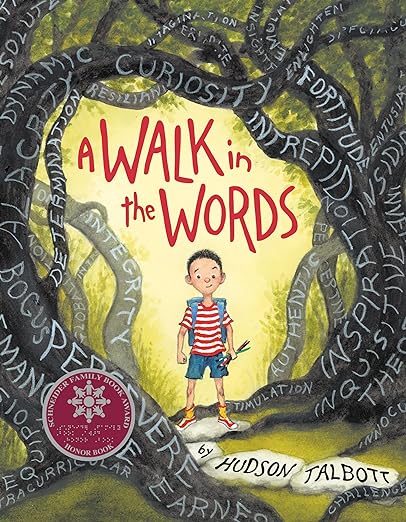Hudson Talbott
When Hudson Talbott was a little boy, he loved drawing, and it came naturally to him. But reading? No way! One at a time, words weren’t a problem, but long sentences were a struggle. As his friends moved on to thicker books, he kept his slow reading a secret. But that got harder every year. He felt alone, lost, and afraid in a world of too many words.
Fortunately, his love of stories wouldn’t let him give up. He started giving himself permission to read at his own pace, using the words he knew as stepping-stones to help draw him into a story. And he found he wasn’t so alone–in fact, lots of brilliant people were slow readers, too. Learning to accept the fact that everyone does things in their own unique way, and that was okay, freed him up and ultimately helped Hudson thrive and become the fabulous storyteller he is today.
My most recent book is A WALK IN THE WORDS. It’s my own story of my struggle with words, reading, and undiagnosed dyslexia as a child, and how it led me toward telling my stories through art. I wanted to share my story with any readers who might relate to it, and given the response I’ve received, it has.

For me, it was a series of lucky breaks. I was a freelance illustrator in New York, a children’s book editor saw my work and looked me up in the Manhattan phone book, we met the next day, I did a book that was a hit, and I have been doing it ever since for the past 30 years. I often submit things that get rejected by my editor with who I’ve done 27 books. I currently have one she rejected over a year ago, and my agent has still not found a home elsewhere. Having a successful book published does help get the next one published but it’s no guarantee.
I wish I had a routine. I’m always working in my head, but creating a new book depends on what stage and how close to a deadline I am. It’s sort of like building a house. The fun part is imagining the concept and bringing it out of the ethers and down into some articulated “blueprint” that I can use to convince my editor it’s viable. Then comes the hard part – laying the foundation, framing it out, etc., until I’m finally arranging the furniture. By that point, it has a momentum of its own that’s pulling me along. That, and a looming deadline.

Overcoming inertia.
Because I illustrate my own stories, I start with the narrative and as I’m developing it, I usually see the opportunities for a good picture, sort of a “photo op” on the journey. But both text and art are subservient to the story. The ultimate concern is what tells the story best. Sometimes a great idea for a picture will alter the path, but usually, it’s an image that gets sacrificed to deference to the more succinct storytelling. Either way, it can be painful.
I can think of at least four developed dummies, rough sketches, and texts in book form, that I have waiting to find a home. Some were sidelined due to external circumstances – a better idea with great urgency eclipsed them, for example. But, as my agent says, sometimes you just put it away and wait a few years.
I accept almost any invitations for public appearances as possible. Book signings, speaking engagements, book festivals, school visits. But these days it’s all about tapping into the online networks. When they start sharing info about your book with each other and it goes viral, it’s the best you can hope for. But I find the idea of keeping an “online presence’ kind of tedious and boring, but I guess it’s a necessary evil these days.
My publisher sends books to all the major reviewers. Because I’ve been published for a while, I usually get reviewed. If there’s a good quote, we usually use it in the PR for the book. I haven’t gotten a bad review in a while, fortunately, but back in the early days, when I did, I always felt like the reviewer didn’t have a clue what the book was about and had no business critiquing it. But attracting people with their own agendas is part of the price for having your work become public.
I don’t have a preference. It depends on the context of the moment.
Not sure I have a favorite author. I illustrated a beautiful story called SHOW WAY, by the gifted author, Jacqueline Woodson. I cried when I first read it and still find it moving 20 years later.
I’m currently working on my 28th book, which is under contract. I’m very fortunate to have had the career path that has transpired so I’m not sure I would do anything differently. I would still make mistakes, just other mistakes than the ones I made and learned from.
The creative impulse is the driving force in my life. Whether I get paid for it or not, I will always be looking for an outward expression of it. But finding a marketable form of it has given me a career. If writing and/or illustrating is what you want to do professionally, then your job is to constantly search for ways to fit what you do and who you are into the market place. If it’s not, then any advice, from me or whoever doesn’t matter. Just have fun learning about yourself through your writing.
Books are like an author’s children, so you love them all for their own qualities. For the latest one, I feel a more immediate sense of service than I ever have before. It’s extremely gratifying to know that I have contributed to strengthening a child’s self-esteem.
Hudson Talbott has written and illustrated over twenty- seven books for young readers. His books have been made into films, musicals, and have won several awards, including a Newbury Honor.
Hudson grew up in Louisville, KY, the youngest of four children and the only one with an interest in the arts. Despite his parents’ orientation toward sports, they supported his artistic pursuits, allowing him to study art in Italy. After living abroad for several years Hudson began his career in New York as a free-lance designer/illustrator, commissioned by The Metropolitan Museum, The Metropolitan Opera, Bloomingdale’s, and the Museum of Modern Art among others. Hudson created his first children’s book for the Museum of Modern Art, called How to Show Grown-Ups the Museum. His next book, We’re Back! A Dinosaur’s Story, was bought and produced as a feature-length animated film by Steven Spielberg, who also bought the film and television rights to other books which followed. Hudson then collaborated with the composer Stephen Sondheim and James Lapine on a book adaptation of their Broadway musical Into the Woods. Two other books, River of Dreams the Story of the Hudson River and O’Sullivan Stew have since been adapted and produced for the stage as musicals for schools and youth theatrical groups.
Hudson’s lifelong passion for travel generated the subject matter for several of his books. Amazon Diary came from his experiences in the Amazon Rainforest with Dr. John Walden, a jungle doctor who brought malaria medicine to remote indigenous tribes. Safari Journal came from his travels with Dr. Jan Grootenhuis, a wildlife veterinarian who worked with the Maasai people in Kenya.
In recent years, the subjects of Hudson’s books have have been closer to home. It’s All About Me-ow captures the “catitude” of his two cats who rule his farmhouse in upstate New York. From Wolf to Woof! The Story of Dogs inspired him to get a dog, a golden doodle named Morgan. Picturing America is the story of Thomas Cole, the first great American artist, who lived in nearby Catskill, and is a companion to his book River of Dreams.
Hudson’s newest book, A Walk In The Words, is his own story about how he turned the challenge of being a slow reader to his advantage. By letting his curiosity and love of language lead him into reading he became a storyteller himself, and discovered that he could paint with words.
Buy on Amazon